-
Welcome to Tacoma World!
You are currently viewing as a guest! To get full-access, you need to register for a FREE account.
As a registered member, you’ll be able to:- Participate in all Tacoma discussion topics
- Communicate privately with other Tacoma owners from around the world
- Post your own photos in our Members Gallery
- Access all special features of the site
Build Thread: Ultimate Bed Drawer System for Camping/Cooking/Tailgating
Discussion in '2nd Gen. Tacomas (2005-2015)' started by cjptacoma, May 29, 2020.
Page 1 of 6
Page 1 of 6


 Weird - Dash Lights
Weird - Dash Lights My rubbers are peeling off (access cab)!
My rubbers are peeling off (access cab)! Code 0430
Code 0430 My 2010 Pre-Runner Build – A Collection of Essential Mods for Every New Tacoma
My 2010 Pre-Runner Build – A Collection of Essential Mods for Every New Tacoma OEM Heated Mirrors DIY mod
OEM Heated Mirrors DIY mod





















